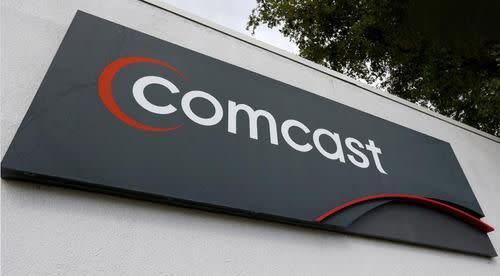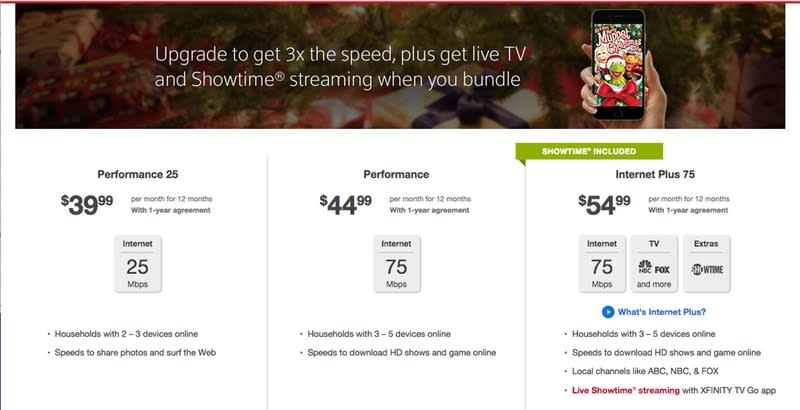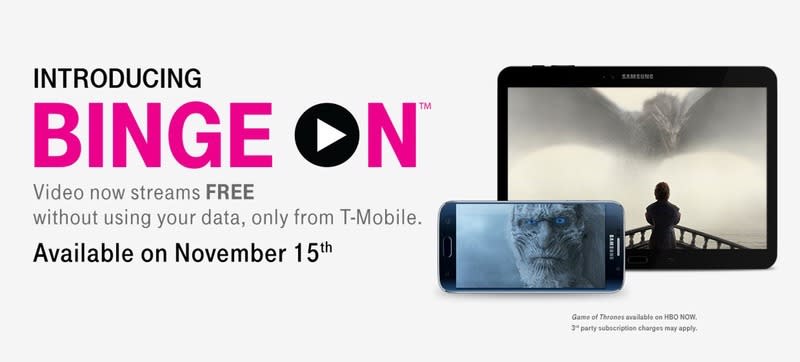Cap as Cap Can: Comcast, T-Mobile Redefine Data Limits in Ways You May Not Like

The pleasant simplicity of unlimited data looks like an increasingly limited proposition in the broadband business.
Billing by the bit doesn’t have to be customer-hostile. But two recent moves — Comcast’s expansion of its Data Usage Plan and T-Mobile’s introduction of a new BingeOn video-streaming service — seem unlikely to improve its reputation.
(FYI, for those of you who are on metered bandwidth plans: Based on download sizes for last week’s column, this one will chew up about 4.2MB of data on a laptop, 3MB on a phone.)
Comcast’s don’t-call-it-a-cap cap
Comcast is no stranger to data caps. The nation’s largest Internet provider imposed a hard 250GB limit on customers until 2012. At that time, the company said it would test a 300GB “threshold” — Comcast wishes you wouldn’t call it a “cap” — with additional 50GB allotments available for $10 each.
About 8 percent of Comcast subscribers exceed that 300GB mark, spokesman Charlie Douglas said Monday; overall, the top 10 percent of its customers account for 50 percent of the data on its network.
In 2013, Comcast added a Flexible Data Option, which cuts your monthly bill by a measly $5 if you accept a 5GB cap but then dings you $1 for each gig over. In September, it began testing an Unlimited Data Option for an additional $30 to $35 per month; last week it said it would expand this scheme to 11 more markets in the South.

This regime of rules governing roughly 12 percent of Comcast customers, according to analyst Craig Moffett, remains deeply problematic.
First, Comcast’s tiers make it difficult, as Douglas phrased it, to “have light data users pay a little bit less.”
That’s because Flexible Data’s 5GB cap is less “light” than “punitive.” A single operating-system patch like Apple’s 1.19GB OS X 10.11.1 update will devour a large fraction of it. And, unlike AT&T or T-Mobile, Comcast offers no data rollover, so you can’t bank unused data one month for a hefty but essential bug fix the next.
Second, the multiple-device reality of home Internet use means you can’t easily track data usage per app as you can on a phone. My living room, for instance, features an HDTV, a Blu-ray player, and a Chromecast, each of them running streaming video apps. But Comcast’s Usage Meter can’t break down how those gadgets might individually binge on bandwidth — if you want to play by Comcast’s rules, Comcast doesn’t give enough help.
Third, Comcast’s usage-based pricing doesn’t scale for speed. If you pay more for a faster connection — the other way Comcast charges heavy data users extra — the 300GB tier stays fixed in every covered Comcast market except Tucson. There, paying for faster speed ups your data limit, but only to 600GB.
T-Mobile “zero-rates” name-brand video
With T-Mobile, the issue isn’t stinginess: This week’s “Uncarrier X” announcement led off with news that the carrier is doubling its existing plans’ data allocations. (I’m on a 3GB plan; I guess I can now ignore my phone’s data-usage graph.) But the second half of T-Mo’s news involved a new BingeOn feature for 3GB and higher plans that exempts 24 video services from those caps.
BingeOn resembles T-Mobile’s “Music Freedom” whitelisting of data used by 33 music services, but it differs from that venture into “zero rating” (i.e. giving people free access to specific parts of the Internet ) in a key way: Video uses much more data.

To get around that, BingeOn-compatible video services must automatically compress their content to a DVD’s resolution when T-Mobile detects them sending video that isn’t adapted to a smartphone’s screen. Engineering services vice president Grant Castle emphasized that this doesn’t give T-Mobile any insight on what you view: “We don’t look at it, we don’t compress the bits.”
If you don’t like the resulting video quality, you can opt out of BingeOn at T-Mobile’s site. But we can’t opt out of what BingeOn might do to video services outside the chosen 24.
T-Mobile says anybody’s welcome and none will pay for the privilege: Its Twitter account said even Verizon’s go90 app is included, sarcastically adding “Rejoice go90 customers! All 17 of you.”
But companies left out will be at an enormous disadvantage, more so than music apps that only sip bandwidth in comparison.
And T-Mobile’s FAQ makes no promises that other video services will get in: “If they meet technical requirements, we’ll investigate the feasibility of adding them.” Castle described those requirements as “not onerous.”
The Federal Communications Commission’s net-neutrality rules banning providers from blocking, braking, or accelerating particular sites already permit Music Freedom and would presumably allow this, too. But some longstanding net-neutrality advocates fear what BingeOn could do to the video market.
One said T-Mobile could fix this by putting customers in charge of zero-rating services.
Public Knowledge staff attorney John Bergmayer suggested this could function as a data credit you grant to sites and pointed to a favorite free-form radio station as an example: “I’d prefer if I could zero-rate WFMU’s audio stream.”
Another asked why T-Mobile even bothers with caps if it can afford to stop metering some of the most data-intensive mobile apps. Said Free Press policy director Matt Wood: “Such arbitrary exemptions call into serious doubt the legitimacy and the need for any kind of cap — unless the ‘need’ in play here is for the carrier to make more money while dictating customers’ usage patterns.”
Limits can still have logic
The weird thing about these debates is that offering alternatives to unlimited use doesn’t have to be that hard. Forget the obvious examples of utilities that bill by usage; the entire genre of prepaid wireless involves paying for what you use, and that can yield some good bargains.
For example, I was delighted to pay only €5 for only a gigabyte of data at the Web Summit in Ireland last week. And when I’m on a plane, I’d rather buy an hour or two of Internet access that I can pause and resume if the alternative is spending more for unlimited access that covers time I could spend snacking or sleeping.
Metered use can be a drama-free development. But companies selling it need to give customers a legitimate chance to save money — without getting too cute with their rules.
Email Rob at rob@robpegoraro.com; follow him on Twitter at @robpegoraro.
More stories from Yahoo Tech:


